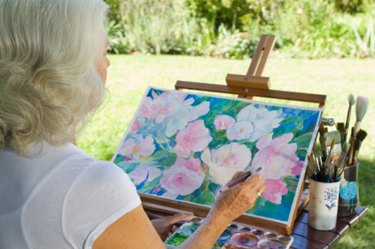
Watercolor is one of the most popular painting mediums for fine artwork, but it can also be one of the most challenging. Watercolors can be unforgiving at times and mistakes permanently render on the paper. Young kids and adults can enjoy this versatile and inexpensive medium for many art projects. Though there are a few disadvantages to using this medium, the advantages are numerous.
Paints
Video of the Day
Watercolor paints are purchased in several different formats. Trays with an assortment of small cakes are generally inexpensive, but contain less pigment than liquid watercolor tubes. The tray paints are easier to facilitate for beginners; but as you progress as an artist the vibrancy and fluidity of liquid watercolors will be a major advantage. Liquid colors are more suitable for mixing larger amounts of paint. Watercolors dry quickly which can be both an advantage and disadvantage.
Video of the Day
Surfaces
Watercolor paper that readily accepts the abuse of scrubbing and washing is often expensive. If you use inexpensive 90 lb. weight paper, it will buckle while doing background washes. The most suitable weight for watercolor paper is from 140 to 300 lb. weight. Watercolors are generally painted on paper, and unfortunately some paper will yellow after a number of years.
Mistakes
Small areas of painting mistakes are often easily remedied with a utility knife or eraser. Watercolor painting requires careful planning with colors -- to avoid muddy and dark areas -- which often cannot be removed. Start your painting with light colors and build to darker tones. If you catch your mistakes while the paint is very wet, you can completely wash the sheet.
Versatility
Watercolors are very versatile and work well with pastels, pen and ink and other water-based paint. Learning to control colors and avoiding a muddy appearance is one of the biggest challenges in using watercolors. Use the transparent colors -- cobalt blue, alizarin crimson and aureollin yellow -- for washes, and you can create many different and interesting effects.
Portability
The transporting of watercolors and basic painting necessities is simple and easy for your outdoor painting excursion or travel. Many miniature watercolor sets are available in stores, equipped with small water containers and brushes. Add a drawing pencil, extra water containers, watercolor pad, paper towels and you are ready to go.